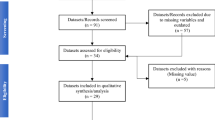Abstract
Aim
Maternal health services potentially play a significant role in improving reproductive health. Access to skilled assistance and well-equipped health institutions during delivery can reduce maternal mortality and morbidity and improve pregnancy outcomes. In this study, we examined the relationship between the use of maternal health care services and the frequency of reproductive health complications (during pregnancy, delivery and after delivery) in Assam.
Subject and methods
We used data from the third round of the District Level Household and Facility Survey (DLHS, 2007–2008) which collects information about reproductive and child health services. Descriptive and multivariate analyses were used to understand the relationship between the use of health care services and the frequency of complications in pregnancy.
Results
Findings show that more than half of women reported having any complication during pregnancy and delivery. Post delivery complications in Assam are reported less by women as compared to any pregnancy and delivery complications. It is also found statistically significant that women who received full antenatal care during pregnancy reported less complications during the delivery and post-partum period. We found a positive correlation in the study area between having any complication during pregnancy with higher reporting of any delivery and post-delivery complication.
Conclusion
The study concludes that use of intensive health-care services reduces health complications. Therefore, it is necessary to improve community awareness on maternal health to motivate women to use more antenatal care services to reduce health complications during the reproductive time span.


Similar content being viewed by others
References
Bhalotra S, Soest A (2005) Birth spacing, fertility and neonatal mortality in India: dynamics, frailty and fecundity. Working Paper RAND Labor and Population. http://www.rand.org/pubs/working_papers/WR219.html. Accessed 13 December 2012
Bhatia JC, Cleland J (1995) Determinants of use of maternal care in a region of south India. Health Transit Rev 5(2):127–142
Census of India (2011) Provisional population tables, vol 1. Registrar General and Census Commissioner, New Delhi, India
Datta KK, Sharma RS, Razack PMA, Ghosh TK, Arora RR (1980) Morbidity pattern amongst rural pregnant women in Alwar, Rajasthan: a cohort study. Health Popul Perspect Issues 3:282–292
Filippi V, Goufodji S, Sismanidis C, Kanhonou L, Edward F, Ronsmans C, Alihonou E, Patel V (2010) Effects of severe obstetric complications on women’s health and infant mortality in Benin. Trop Med Int Health 15(6):733–742
Harrison KA (1990) The political challenge of maternal mortality in the third world: a challenge to political leaders. Women’s Global Network for Reproductive Rights, Manila, Philippines, pp 6–7
International Institute for Population Sciences (IIPS) and Macro International (2007) National Family Health survey (NFHS-3), vol 1. IIPS, Mumbai,
Ministry of Health and Family Welfare (MOHFW) (1997) Reproductive and Child health Programme: schemes for implementation. Department of Family Welfare, New Delhi
Ministry of Health and Family Welfare (MOHFW) (1998b) Family Welfare Programme in India, year book, 1996–97, Dept. of Family Welfare, MOHFW, New Delhi
Oomman N (2000) A decade of research on reproductive tract infections and other gynaecological morbidity in India: what we know and what we don't know. In: Ramasubban, Jejeebhoy (eds) Women's reproductive health in India. Rawat Publications, New Delhi, pp 236–279
Osmolska D (2011) Unplanned pregnancies more frequent among poor women. Emax Health, Hickory, NC http://www.emaxhealth.com/. Accessed 12 January 2013
Pachauri S (1994) Women's reproductive health in India: research needs and priorities. In: Gittelsohn et al (eds) Listening to women talk about their health. Issues and evidence from India. Har-Anand Publications, New Delhi, pp 15–39
Papia R (2005) Pregnancy complications and health-seeking behaviour among married women in Uttar Pradesh, India. Res Pract Soc Sci 1(1):48–63
Rishyasringa B (2000) Social policy and reproductive health. In: Ramasubban, Jejeebhoy (eds) Women's reproductive health in India. Rawat Publications, New Delhi, pp 418–442
Sample Registration System (2009) Special bulletin on maternal mortality in India. Office of the Registrar General, New Delhi, India
Sample Registration System (2011) Maternal and child mortality and total fertility rates, Office of Registrar General of India, New Delhi. http://censusindia.gov.in/vital_statistics/SRS_Bulletins/MMR_release_070711.pdf. Accessed 9 February 2013
The Hindu (2010) Assam records highest maternal mortality rate in the country. http://www.thehindu.com/sci-tech/health/policy-and-issues/assam-records-highest-maternal-mortality-rate-in-the-country/article183147.ece. Accessed 05 January 2013
World Health Organization (WHO) (1987) Preventing the tragedy of maternal deaths: a report on the International Safe Motherhood conference. Nairobi, Kenya
World Health Organization (WHO) (1999) World Health Report 1999: Making a Difference. Geneva
World Health Organization (WHO) (2000) Pregnancy exposes women in poor states to 200-fold risk of death, compared with rich ones. Populi 27(2):4
World Health Organization (WHO) (2004) Beyond the numbers: reviewing maternal deaths and complications to make pregnancy safer. WHO, Geneva. http://www.ino.searo.who.int/LinkFiles/Reproductive_health_Beyond_the_numbers.pdf. Accessed 13 December 2012
Acknowledgements
The authors thank International Institute for Population Sciences, Mumbai for providing the District Level Household and Facility Survey III 2007–2008 data. The authors would also like to acknowledge the contribution of the editor and two anonymous reviewers for their comments and suggestions to improve the paper.
Conflicts of interest
The authors declare that there is no conflict of interest.
Author information
Authors and Affiliations
Corresponding author
Rights and permissions
About this article
Cite this article
Gogoi, M., Unisa, S. & Prusty, R.K. Utilization of maternal health care services and reproductive health complications in Assam, India. J Public Health 22, 351–359 (2014). https://doi.org/10.1007/s10389-014-0614-y
Received:
Accepted:
Published:
Issue Date:
DOI: https://doi.org/10.1007/s10389-014-0614-y




